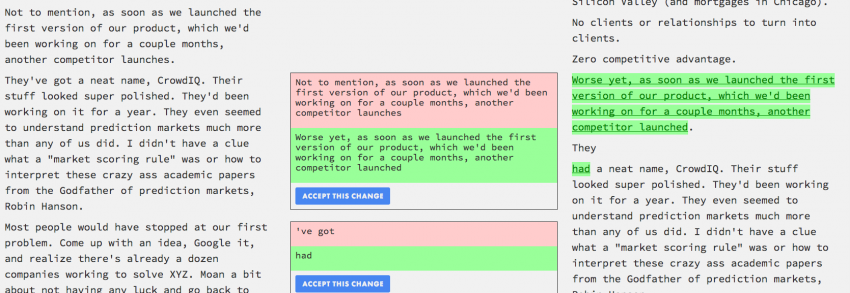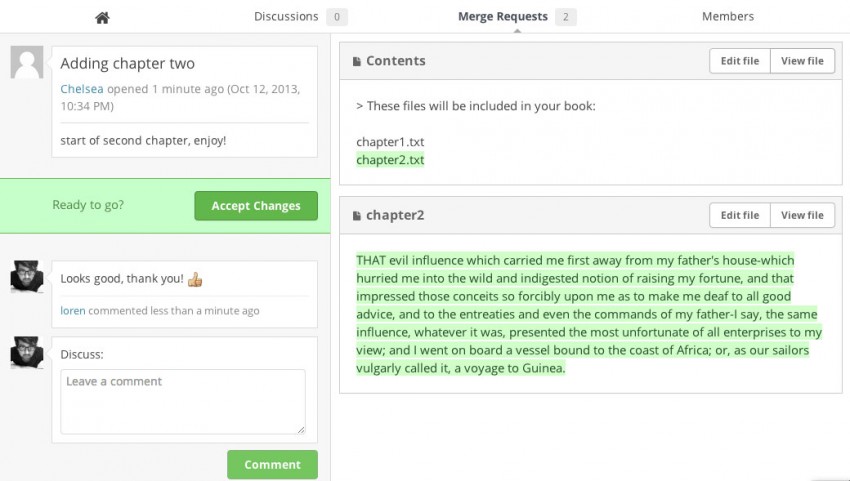
I once worked at a content creation agency in Boston where we churned out an exorbitant volume of content for client companies’ websites on a daily basis. Each writer was responsible for 15-20 stories per day that ranged from 200 to 500 words. We peer-edited and posted all of our work in a proprietary CMS, and the editing process was as follows:
- Receive influx of emails from co-workers requesting story edits.
- Suggest edits in Gmail by manually highlighting them in different colors.
- Email colorfully edited story back to co-worker, who copy/pastes the revision into the CMS to be published.
This was 2011. And it was terrible.
Collaboration on the web has always been a challenge. Beyond the typically one-dimensional CMS, other familiar tools such as Google Docs and Dropbox also fall short because they either lack multimedia support (Docs) or don’t offer a true version control system (Dropbox).
Over the past year-and-a-half, however, a host of potential collaboration solutions have emerged. The first, and perhaps most prominent, Editorially, recently shut its doors despite much fanfare from users. Penflip and Draft offer similar functionality, while GitHub, long predicted by some to be a newsroom game changer, supports a content editor called Prose. It’s clear that people are starting to think more about improving collaboration among content creators.

“I think the collaborative editing space has been largely overlooked because quality digital content has never been a top priority for most people,” says Loren Burton, founder of Penflip. “This is shifting as online content becomes more and more important. Producing quality content requires collaboration and good tools.”
Penflip, which Burton has dubbed the “Github for writers,” takes a very literal approach to collaboration and applies the same workflow concepts that Github uses. As he explains in more detail on his blog, multiple editors can make changes via their own “branches,” or personal versions of the original “master” document. Once changes are made, they submit a request to the author to accept or deny the changes, which all other collaborators on the project are able to see. If accepted, those changes are merged onto the main document.
Penflip also supports Markdown, an easy-to-use formatting syntax that is easily converted HTML, which means anything you can do in Markdown — such as inserting links or multimedia — you can do in Penflip. However, Burton notes that Penflip currently only supports image hosting, while audio and video must be hosted elsewhere.

The term “version control” might be foreign to web producers without a deeper technical background, but the concept is far from new. As Nate Kontny, founder of Draft, points out, writers have used similar methods with Microsoft Word for years, saving documents with different version numbers so they didn’t miss out on any changes. Version control has made manually saving each iteration and building up unnecessary files an antiquated process. The journalistic community should learn to embrace these modern interpretations, because people are still “petrified of losing their stuff,” Kontny says.
Most of these systems attempt to improve content collaboration before it gets to the CMS, or as London-based GatherContent says, the “pre-CMS” experience.
GatherContent’s founder James Deer’s background is in commercial work, but his experience is typical of news publishers large and small.
“Typically a CMS isn’t great around content collaboration,” he said. “All of the content we’d need to post would arrive in dribs and drabs — word documents, spreadsheets, emails, physical leaflets etc. It meant that my clients and I would waste huge amounts of time deciphering everything into a format ready for the CMS.”
GatherContent acts as a space for teams to, as Deer puts it, “centralize” all CMS content to iterate on and approve before it’s ready to be posted, which is just the problem many publishers face. They haven’t yet incorporated support for audio or video, but it’s a next step.
The collaborative editing space is headed in the right direction, but there is still work to be done. While Medium, the popular writing platform, has taken blogging to the next level by adding peer editing features and multimedia support, rich media integration remains a stumbling block for version control-based text editors. That said, in a fairly short period of time we’ve advanced well beyond bloated Word files and colorful email edits, and journalists and web makers alike should continue to experiment with these tools and act as advocates for change with the goal of spurring new advancements.




